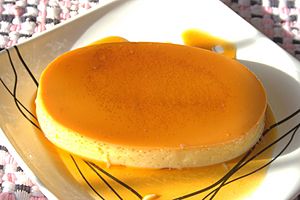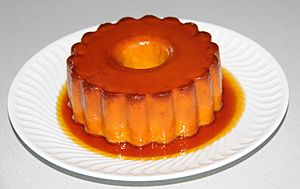Crème caramel facts for kids

Rows of crèmes caramel or flan
|
|
| Alternative names | Flan, caramel custard |
|---|---|
| Course | Dessert |
| Place of origin | Spain, Roman Empire |
| Region or state | Southern Europe |
| Serving temperature | Cold or warm |
| Main ingredients | Eggs, milk, sugar |
| Variations | Crème brûlée, crema catalana |
Crème caramel is a yummy dessert that's also known as flan or caramel custard. It's a smooth, creamy custard with a sweet, clear caramel sauce on top. People all over the world enjoy this sweet treat!
Contents
The Story of Crème Caramel
The history of crème caramel, or flan, goes way back to the Roman Empire. Back then, it was called tiropatinam. It was made with eggs, milk, and pepper. Sometimes, people added savory things like fish or spinach. But there was also a sweet version made with honey.
Later, in the early Middle Ages, people in Spain started making it more like the flan we know today. They added caramelized sugar to the mix. This is when it got the name "flan," which comes from an old German word for a flat cake.
In the late 1900s, crème caramel became very popular in European restaurants. One reason might be that it's easy to make a lot of it ahead of time.
What's in a Name?
The word crème in French means 'custard'. Names like crème (caramel) renversée (French) and crema volteada (Spanish) mean that the custard is "turned over" when it's served. This is because the caramel sauce ends up on top!
Both crème caramel and flan are French names. But the word flan means different things in different places.
In countries where people speak Spanish, and often in the United States, crème caramel is called flan. This is especially true in Latin America. But in places like Britain, a flan is a type of tart that's more like a quiche.
The English word flan comes from the French word flan. This word has a long history, going back to an old German word for a flat cake.
How It's Made and Served
Making Crème Caramel
Crème caramel is a special kind of custard. First, a sweet sugar syrup is cooked until it turns into caramel. This caramel is poured into the bottom of a mold. Then, the creamy custard mix is poured on top.
It's usually cooked in a bain-marie, which is like a water bath. This can be done on a stovetop or in the oven. Cooking it in a water bath helps the custard cook gently and evenly. It also stops the caramel from burning.
When it's ready, the dessert is flipped over. This makes the caramel sauce flow over the custard. That's why it's sometimes called "crème renversée," meaning "flipped cream." You can add flavors like vanilla, cinnamon, or lemon peel to the milk.
The finished dessert is smooth and creamy, a bit like jelly.
Serving It Up
It can be tricky to flip over a very large crème caramel without it breaking. So, it's often cooked and served in smaller, individual dishes called ramekins. This way, each person gets their own perfect dessert! The goal is to have a smooth, creamy top with a runny caramel sauce at the bottom.
Quick Versions
Sometimes, you might find "instant flan powder." This powder uses things like agar or carrageenan to make the dessert thick, instead of eggs. In some Latin American countries, the real egg custard is called "milk flan" (flan de leche). The quick version is just called "flan."
Crème Caramel Around the World
Spain
In Spain, flan is a very common homemade dessert. You can find it in grocery stores and most restaurants. The most famous kind is Flan de huevo (egg flan). But there are many other kinds, like cheese flan (flan de queso) or vanilla flan (flan de vainilla). The original flan has a layer of caramelized sugar that can sometimes be hard.
Argentina and Uruguay

In Argentina and Uruguay, crème caramel is often eaten with dulce de leche (a sweet milk caramel), whipped cream, or both! When it has both, it's called flan mixto.
Brazil and Venezuela
In Venezuela and Brazil, this dessert is often made with condensed milk, milk, eggs, and caramelized sugar on top. The Venezuelan version is called quesillo ("small cheese"). In Brazil, it's known as pudim ("pudding"). You can find it in many flavors, like chocolate, coconut, or cheese.
Caribbean
In many Caribbean countries, people often add coconut, condensed milk, and evaporated milk. The milk base can also be flavored with nuts or fruit.
Chile
In Chile, Leche asada (roasted milk) is similar to crème caramel. It uses the same ingredients but has a less smooth texture. It's baked directly, which creates a toasted layer on top. In Chile, it's often eaten with quince jelly or condensed milk.
Costa Rica
Flan in Costa Rica often has coconut or coffee flavors.
Croatia
In Croatia, the dessert is called rožata. It's flavored with a special rose liqueur from Dubrovnik, which gives it a unique smell. Modern versions might use vanilla or other flavors.
Cuba
Cuban flan (flan de Cuba) is made with the whites of two eggs and a cinnamon stick. A similar Cuban treat is Copa Lolita, which is a small caramel flan served with vanilla ice cream. Other kinds include coconut or rum raisin toppings.
Dominican Republic
In the Dominican Republic, only egg yolks are used, mixed with vanilla, evaporated milk, and condensed milk. Coconut flan is also called quesillo.
India

Caramel custard is very popular in India, especially in big coastal cities and former Portuguese areas like Goa. It's a common dessert in restaurants and made often in homes by certain communities.
Japan
You can find packaged crème caramel everywhere in Japanese convenience stores. It's called purin (プリン), or custard pudding. The same dessert is also sold in convenience stores in Taiwan.
Malaysia
Caramel custard is a very popular dessert in Malaysia. The Portuguese first brought it in the 1500s. Today, it's sold all year round in restaurants, cafes, and hotels. It's also popular during Ramadan for breaking the fast.
Mexico
Flan is super popular in Mexico. People make it at home, buy it in stores, eat it in restaurants, and even buy it from street vendors. A special kind called Flan Napolitano is made with cream cheese for a creamier texture. Another type is "Flan de Cajeta," which uses goat milk caramel instead of regular caramel.
Peru
In Peru, crema volteada ('flipped cream') might use condensed milk instead of regular milk. Fruits like lucuma, custard apple, or granadilla can also be added.
Philippines

In the Philippines, flan is known as leche flan. This is a richer version of the Spanish dish, made with condensed milk and more egg yolks. Leche flan is usually steamed in oval-shaped tin molds called llanera. It's a must-have dessert for celebrations.
There's an even richer version called tocino de cielo (Spanish for "heaven's bacon"). It has even more egg yolks and sugar.
Leche flan is also baked into other treats. A common one is leche flan cake, which is a sponge cake with a layer of leche flan on top. It can also be baked into steamed cupcakes called puto mamón, a mix known as puto flan.
Portugal

Known as Pudim flan, this dessert is made with milk, eggs, caramelized sugar, and vanilla. Some versions include orange or lemon zest, cinnamon, pineapple, or even Port wine. A famous one is Pudim Abade de Priscos, which even has bacon! It often has a hole in the middle.
Puerto Rico
Most Puerto Rican flans are made with eggs and milk. The egg whites and yolks are beaten separately with sugar to make a light flan.
Flan cake is called flancocho and has cream cheese added.
Unique Puerto Rican flans include flavors like Spanish lime, piña colada, pumpkin (flan de calabaza), sesame seed milk, and breadfruit.
Vietnam
Crème caramel was brought to Vietnam by the French. It's known as bánh lăng, caramen, or kem caramel in northern Vietnam, and bánh flan or kem flan in southern Vietnam. Sometimes, people pour black coffee on top. Or, they might cook the caramel longer to make a darker, more bitter "burnt caramel."
See also
 In Spanish: Flan para niños
In Spanish: Flan para niños





